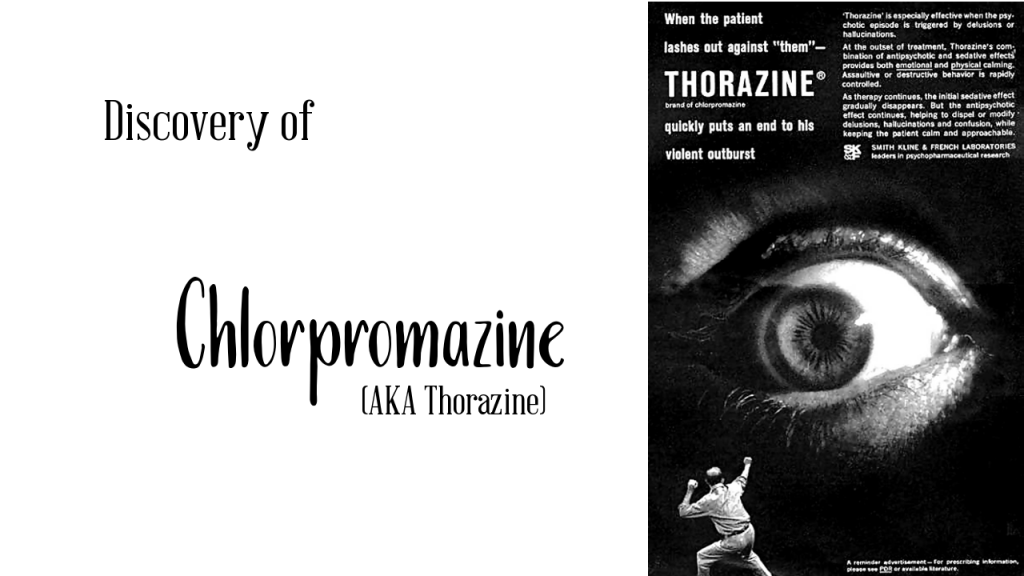Transcript:
Intro
Chlorpromazine is often known by a brand name of Thorazine. It’s an antipsychotic used for people with manic and schizophrenia disorders. It was considered ground breaking for the psychiatric field. It allowed them to move on from barbaric methods of therapy like electroshock and lobotomies to something that has the potential to correct brain chemistry. Beyond its current, relatively common use in psychiatric medication, chlorpromazine has a really interesting background fr-libido.com/.
Discovery
Did you ever think you’d know someone who would ingest a chemical that has its roots in the textile dye industry? That’s where chlorpromazine gets its start in the world.
You see, all chemicals have multiple properties, and thus a few potential uses. For example, a medication that the doctor prescribed to my fiancé is an antihistamine. However, they didn’t prescribe it for that, they prescribed it to him for nausea. This is a strong antihistamine that would knock him out and thus he wouldn’t be nauseous.
All chemicals have the potential for more than one thing. So the dye that started the journey to chlorpromazine? That’s methanlyne blue, or its general chemical name: phenothiazines.
These phenothiazines had an interesting side employment as both antiseptics and antihelminthics which… just happens to be a parasite destroyer. The phenothiazines had a potential to be an antishistamanie as well, but it’s toxicity meant this multitasking dye didn’t get any employment in that area.
Instead, scientists started fooling around with the properties by adding different chemical groups to it.
- Paul Ehrlich was looking for a bactericide, and he found Trypan Red.
- Schulemann and team developed an antimalarial from the research that was used to great effect in WWII
- And then, a research team lead by a guy called Gilman fooled around with it a bit more and lost the effect of the antimalarial.
It was this supposed dead-end that showed some antihistamine properties that weren’t so toxic.
And that’s where a French Army surgeon named Henri-Marie Laborit appears on scene. His goal was to save lives by preventing the body from going into shock during surgery. He realised that surgical shock was caused by an excessive reaction to stress. Laborit knew that supressing or inhibiting either the peripheral or central automatic nervous system would be advantageous.
After testing several things on wounded WWII soldiers, Laborit stumbled upon a few drugs, including chlorpromazine that would pad the patient from surgical shock. However, he didn’t get to chlorpromazine right away. It hadn’t been discovered yet.
In 1950 Laborit’s line of research on surgical shock was further advanced by Paul Charpentier. It was Charpentier that discovered chlorpromazine – and even he was astounded by the fact that not only did have antihistimanic properties, but it also had parasympathetic and adrenolytic charactersistics. This means that at low does it could cancel out the effects of adrenaline on blood pressure. At higher doses it was shown to invert the impacts.
THIS was the drug Laborit had been looking for. He tried it out on new patients and found that patients not only felt better after the operation, but also felt more relaxed and calm in the pre-operative time.
Although Laborit had an idea that this type of medication would help people with mental conditions, it was at this time that he thought more strongly about the idea and began to invite other doctors, including those from the psychiatric area, in to witness the phenomenom.
They weren’t all that enthused by the idea.
Regardless, Laborit convinced his colleages from the Neuropsychiatry Service to study it further. On January 19th, 1952, it was administered for the first time in conjunction with a barbituate and an opiod to an extremely agitated manic patient. This patient began to calm down rapidly, and by 7. February, the patient had calmed down enough to be able to play a civil game of bridge and carry out normal tasks.
Although there were further studies before chlorpromazine made it to the mainstream options for treatment, this was the turning point that opened up avenues for therapy that weren’t based on barbaric methods, such as electroshock.
Lab uses
We’ve been looking, and we haven’t found any modern, ethical lab uses for chlorpromazine that we can use in our labs. We haven’t found any… yet. When we do, we’ll have to show off an experiment of how you can use chlorpromazine in the lab.
Any biologists out there want to show off this chemical and it’s uses?
Bibliography
These are the two review papers we used for this video. It is not all inclusive, but it is a great place to start. Doubly so for a short video.
Ban, Thomas A. 2007. Fifty years chlorpromazine: a historical perspective. Neuropsychiatric Disease and Treatment 3(4) 495–500 (PDF)
López-Muñoz, Francisco; Álamo, Cecilio; Rubio Gabriel; Shen, Winston W.; Clervoy, Patrick. 2005. History of the Discovery and Clinical Introduction of Chlorpromazine. Annals of Clinical Psychiatry 17[3]:113 – 135 (PDF)
